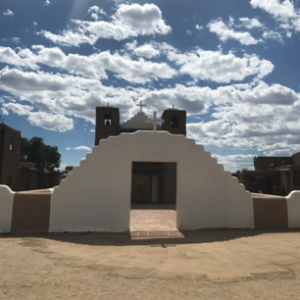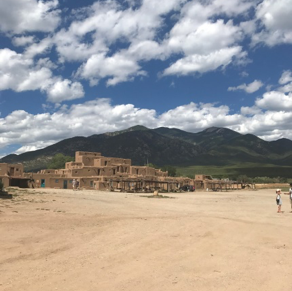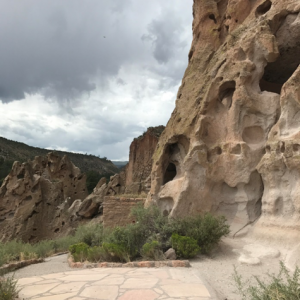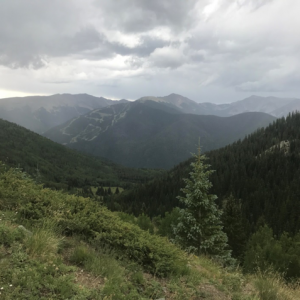
Posing in front of the Rio Grande Gorge in the middle of a run along the Rift Valley trail
The following post was contributed by Alumni Memorial Scholar Denise Larson ’19, who recently completed an independent research project, using her AMS grant funds, observing classrooms in Taos, New Mexico.
From August 12th to 22nd 2017, I went to Taos, New Mexico to complete an AMS project entitled, “Classroom Observations in Taos, New Mexico.” As a prospective member of Colgate’s 5-year Master of Arts in Teaching program, I’m required to get 100 observation hours in classrooms spanning the grades that compose the secondary level of education. Further, those hours must comprise a diverse body of students and schools, with traits such as disabilities, poor socioeconomic status, and English Language Learners (ELLs).

Main entrance to Taos Middle School
The latter was proving to be a challenge to observe in upstate New York, so I decided to go to Taos Middle School upon the suggestion of my teammate Hannah Gunther who attended that middle school. The school is 98% Hispanic, 100% free and reduced lunch, and they have a thriving bilingual program. Not only would I be able to satisfy numerous requirements for my observation hours, but I’d do so much more fully than I could have hoped to emulate in upstate New York.

My view in a 6th grade social studies class immediately before the students arrived
I spent 30 hours in the school and observed social studies classes, bilingual language arts classes, and even an advanced mariachi class. A typical day for me looked like getting dropped off amongst the middle schoolers at 7:40 and then proceeding to observe classes until the end of the school day at 2:45. I would sit in the back of the classroom and take notes on a legal pad.
I was particularly paying attention to classroom management strategies, how curriculum was differentiated for students with different learning preferences (particularly ELLs), and also those stand-out moments in classrooms that establish classroom culture. Coming off of a summer that I spent teaching for the first time, I found myself incredibly attune to the nuances of classroom life at Taos Middle School, and loved every minute of my 30 hours there.
By the end of the week, I even found students approaching me for help as I’d managed to establish myself as a credible figure in the classroom. Those brief moments, in tandem with my pages upon pages of notes have given me a wealth of knowledge to draw upon moving forward in my teaching career. I learned that the smallest adjustments make a difference, such as having written directions in addition to oral directions. I learned the importance of validating students’ cultures in the classroom, but also the importance of maintaining control and encouraging students to follow appropriate norms that the school has established. I learned that there are a wide variety of teaching styles and that no style is innately more effective, but that stylistic choice depends on what type of classroom environment a teacher wants to cultivate. Ultimately, I gained a new appreciation for the role of intentionality in the classroom, and the responsibility the teacher has for making the effort to be intentional.

My view of an 8th grade U.S. History class
In addition to the vastly foreign environment I found myself in at Taos Middle School, I also felt transported to another world just being in Taos, New Mexico. As such, my trip to Taos doubled as a cultural experience. I visited Taos Pueblo, and witnessed firsthand the rich Native American culture that flourishes in Taos to this day. This connects to my experience at Taos Middle School because there are some kids at the school who come from the Pueblo, and their culture dictates the way they navigate the school day.
My appreciation for the preservation of Native American culture was reaffirmed when I visited Bandalier National Park, which is home to cliff dwellings created and inhabited by Native Americans hundreds of years ago.
The themes of creativity and resourcefulness that I appreciated at Bandalier were re-emphasized at Meow Wolf, which is an interactive installation art exhibit that is a collaboration of over 100 local artists in Santa Fe.
Meow Wolf was the only exploration of New Mexico I did (besides in the classroom) that took place indoors, as I was enamored by the desert and mountain vistas. I gazed upon the Rio Grande from the Gorge Bridge, and visited the earth ships that sprouted up nearby. The earth ships are sustainable homes that people have built and live in year round with the aim of preserving the environment as well as living simply, and the location seemed fitting in close proximity to the beautiful Rio Grande.
Another day I hiked down to natural hot springs that reside adjacent to the Rio Grande, and that was the lowest point (literally, not figuratively!) of my time in Taos.
The highest point of my time in Taos came from hiking in the Taos ski valley up to a peak elevation of 11,200 feet. The chance to overlook the tourist-destination Taos ski valley as well as the town of Taos took my breath away (at least what remained after hiking 2000 feet of elevation gain!).
I also got to eat some of the best Mexican food I’ve ever had, and get in some high altitude running.
I found myself thinking and verbalizing that New Mexico is the coolest place I’ve ever been, and that was a combination of my experience both in Taos Middle School and across the town of Taos and the state of New Mexico. This wouldn’t have been possible without the help of Colgate’s education department for motivating me to have a rich observation experience, the AMS program for support throughout the grant application process, and the Gunther family for taking me in for my 10 days in Taos as well as being phenomenal tour guides. So a big THANK YOU to everyone who gave me this opportunity and helped me to maximize it!



















